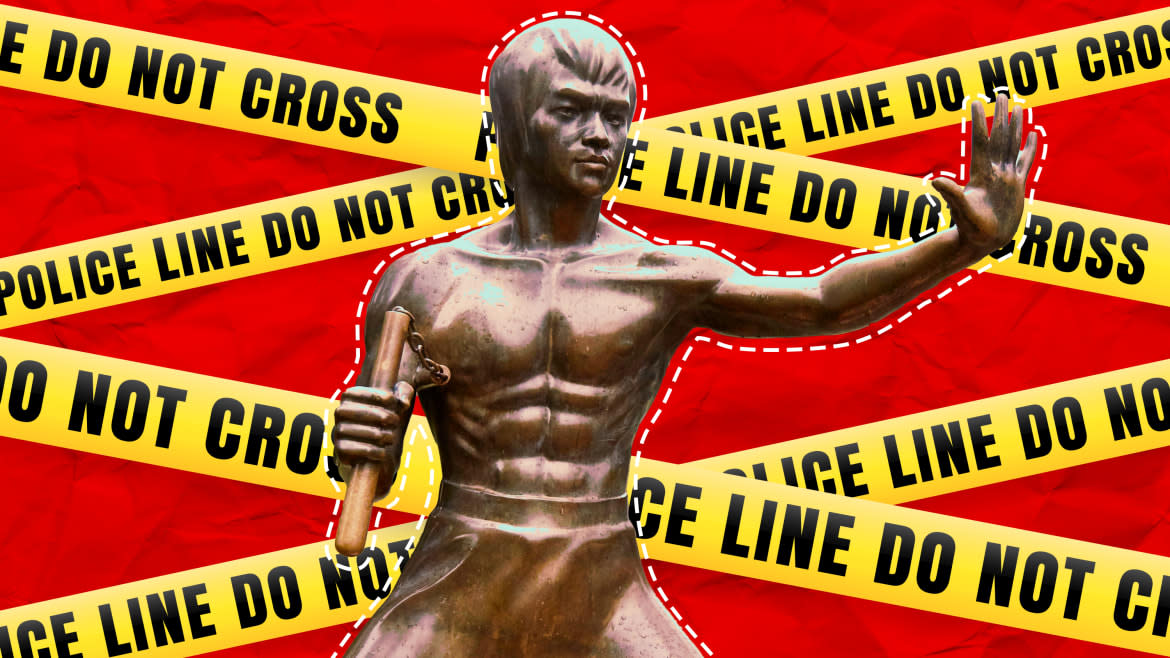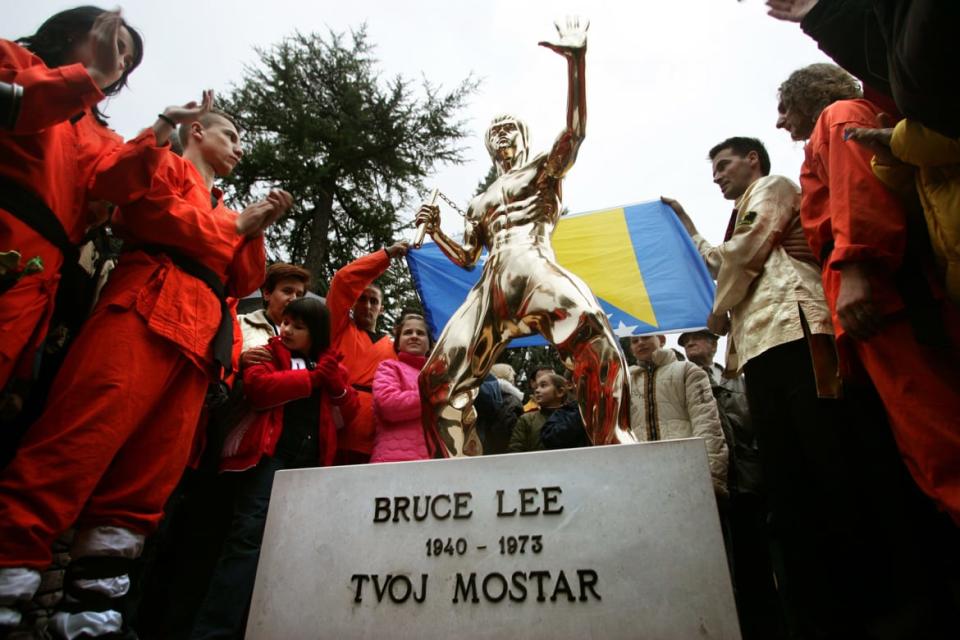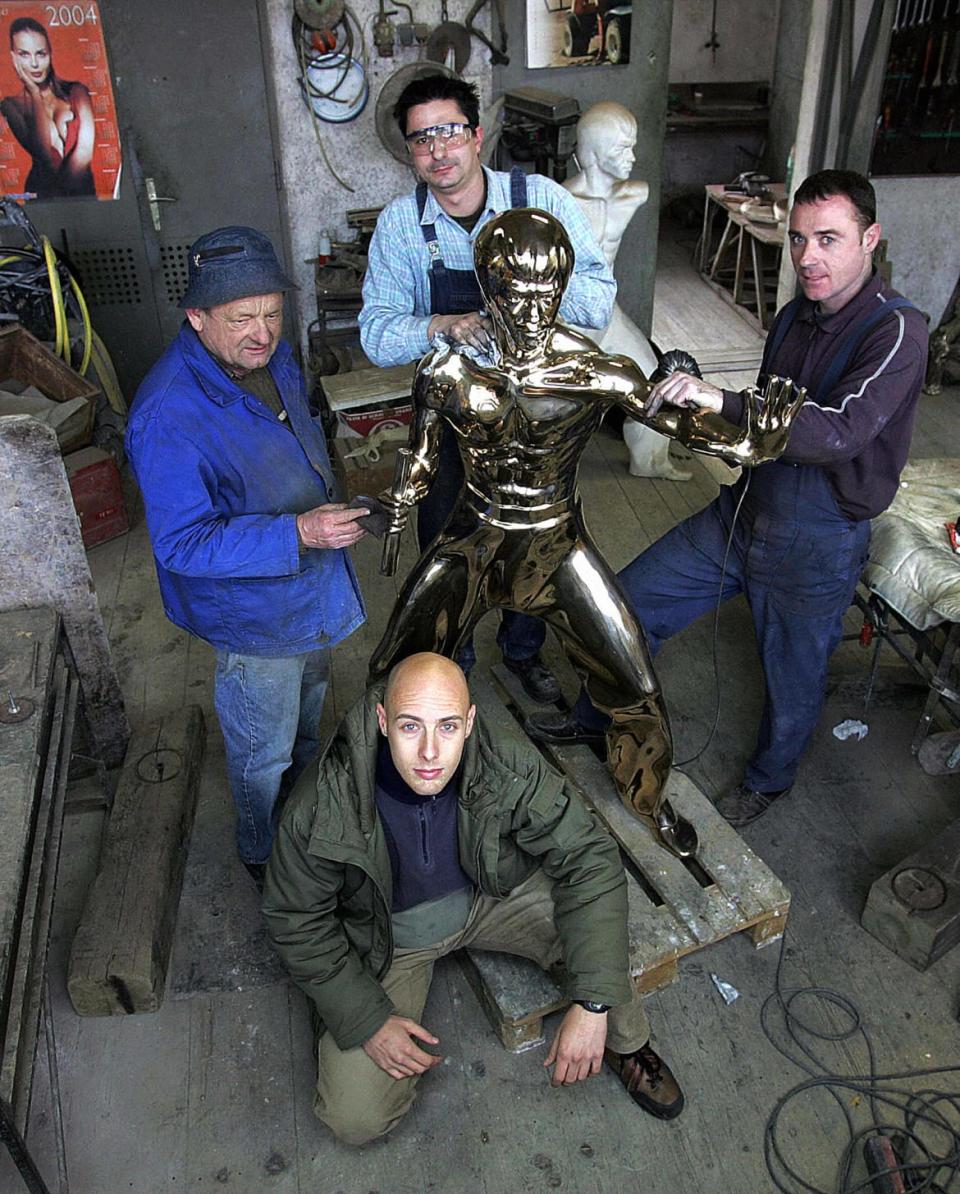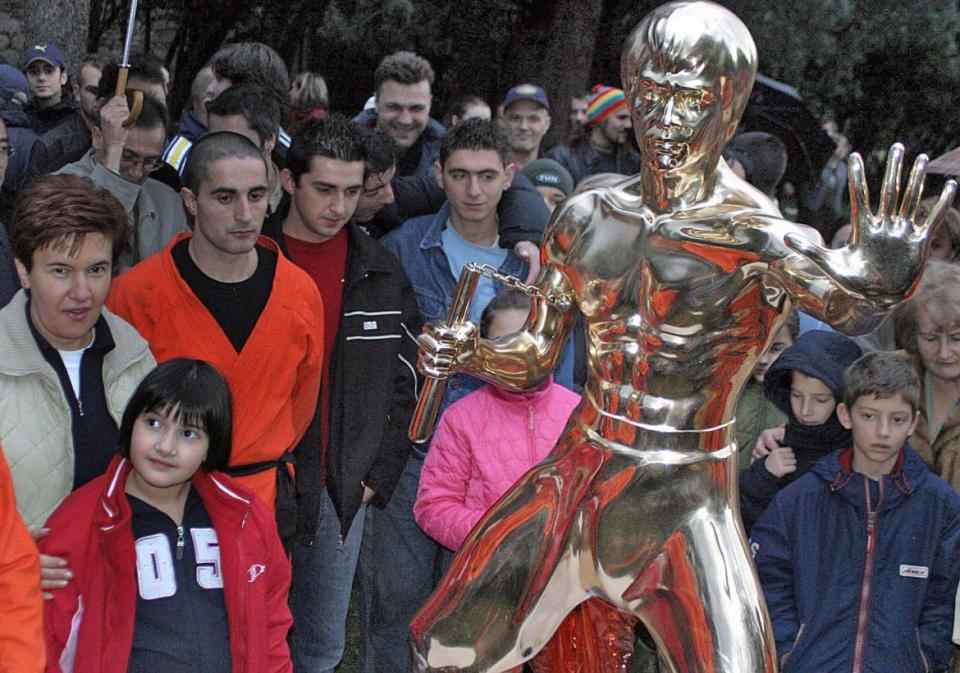The Wild True Story of the Bruce Lee Statue Heist

MOSTAR, Bosnia—It started as a joke. Bosnian writer Veselin Gatalo and two of his friends were sitting in a café at the start of this century talking about heroes. At the time there were plenty of war heroes in Bosnia and Herzegovina, where ethnic conflict between Serbs, Croats and Bosniaks in the 1990s left around 100,000 dead. After watching one of these “heroes” insult a waiter, Gatalo, who is Serbian, turned to his friends, Sanjin Plakalo, who is Muslim, and Nino Raspudić, who is Croatian.
“Does this country have any heroes?” Gatalo asked.
“We do not,” came the reply.
A minute later there was another answer. They did have a hero. His name was Bruce Lee.
Growing up in Mostar in Yugoslavia’s Bosnian republic in the ’70s and ’80s the trio had watched the martial arts star beat up bad guys on the big screen. Lee’s belief in tolerance and unity, especially between East and West, resonated with them. Lee had a large fan base throughout the six deeply divided Balkan countries that once made up communist Yugoslavia. To the young trio it made more sense to build a monument to a martial arts hero than to a real-life fighter who would be considered a hero by some and a criminal by others.
Somehow the media got hold of their ramblings and gave them substance. It was reported that Gatalo and his friends were going to build a monument to Bruce Lee in the Balkan city of Mostar—so they did. Foreign officials showed up for the unveiling and international media outlets wrote celebratory features. It was a huge hit.
Two decades later, in March of this year, the life-size monument was stolen, leaving the men most responsible for bringing Lee’s likeness to this war-torn region wondering how a symbol of unity could simply disappear.
It happened overnight. On March 2, Bruce Lee was there. On the morning of March 3, Mostar residents awoke to find him missing. The abduction was widely reported, but information from local authorities was sparse. Theories abounded. Some thought it was a prank. Others believed it was part of a larger political trend of tearing down monuments. The truth remained elusive.

Bosnian Kung Fu practitioners unveil the bronze statue of Bruce Lee in Mostar, Bosnia and Herzegovina, Nov. 26, 2005.
Like the stories surrounding his disappearance, reports about Lee’s creation were incomplete and twisted into an urban legend. The organization the media credited with bringing the bronze Bruce Lee to Mostar, Urban Movement Mostar, existed solely to build the monument. As for the infamous poll that supposedly saw Lee beat out the Pope and Gandhi to the honor of a statue in Mostar; it never happened. From the start there was only one hero, the short and wry fighter of mixed heritage who starred in films in which the good guys always won.
“Bruce Lee was close to us and so far away from us,” Gatalo says. “He wasn’t Catholic, Orthodox, Muslim, but everybody could find a part of himself in him.”
Today, Gatalo, 56, is sitting in a café in Mostar again. He is bald now, with a bit of a belly and 16 published books to his name. A father, husband and fruit farmer, Gatalo is sipping coffee and smoking cigarettes within several hundred yards of where the monument once stood. All that is left of Lee is the base, discoloration marking where the great man’s feet were once affixed in a fighting stance.
The Mostar monument was the first Bruce Lee monument in the world, beating out Hong Kong, where Lee was raised, by a day. Gatalo claims it was only after they announced their endeavor that Hong Kong decided to follow suit. Mostar may have had the lead but because they insisted on doing everything legally, following all the bureaucratic procedures, the race was close.
“If you want to do something right, in the right way, the way is more important than the act,” Gatalo says.
Nevertheless, the act itself was impressive. The monument, which was unveiled in November 2005, made Mostar famous for something besides the war and its rebuilt 16th-century bridge, Stari Most. Plakalo, who was presenting his master’s thesis in Paris during the final stage of the project, wrote in an email that he saw it “as an illustration of the Mostar spirit of wisdom and humor”.

Croatian sculptor Ivan Fijolic, center, and his team with their statue of martial arts film legend Bruce Lee, on Nov. 24, 2005.
Bruce Lee fans from around the world traveled to Mostar to see it. Taxi drivers told Gatalo that “everyone wanted to see Bruce Lee.” Raspudić describes how new brides posed for pictures beside the monument, their hands striking Lee’s in a high five.
“Bruce Lee in Mostar after the war was the first positive thing that was shared by all the people in Mostar and all the people globally,” Raspudić says in a video call from Croatia.
Back then Raspudić was a 20-something dealing theoretically with postmodern art. Now he is a Croatian lawmaker sneaking in a call while his young child sleeps. Looking back on that time, he ponders with why the statue caused such a stir. He says the monument was not recognized as high culture because it didn’t depict a general or president. It was of a movie star, an example of popular culture. And it captured people’s imaginations because of the unusual location: Here was a tribute to Bruce Lee, not in Hong Kong, where Lee had roots, but in the distant Balkans.
“It was some kind of positive shock, because everybody, all the people were happy without knowing; they couldn’t explain why they were so happy about that,” he says.
Today there are new wars, in Gaza and Ukraine, conflicts Raspudić finds depressing because it seems there is no way out.
“I’m not naïve,” he says. “I don’t think that art in public space could save the world, but it can make space in our imagination, also cultural and political imagination, a little bit larger.”
In Raspudić’s mind the destiny of the monument mirrors that of the city. Before the Bosnian war, which lasted from 1992 to 1995, Mostar had the highest percentage of ethnically mixed marriages in the region. During the fighting in Mostar the boulevard that splits the city became the frontline, separating the Bosniaks in the east from the Croats in the west. The conflict damaged most of the city’s buildings and left thousands dead and displaced.

Local people surround the statue of late martial arts legend Bruce Lee in the southern Bosnian city of Mostar, Nov. 26, 2005.
Like Mostar’s citizens, the monument would soon become “some kind of refugee” says Raspudić. He was describing the statue’s six-year exile after an act of vandalism. Within days of its installation, someone stole the fighter’s signature nunchuck fighting sticks.
According to Mostar sculptor Željko Marić, who was eventually hired to make the repairs, Lee was out of commission for so long because the city could not afford to send the monument to the foundry. Instead, in 2011, they hired Marić. The art instructor wasn’t sure he would be able to complete the task. It wasn’t that Lee was in such bad shape. Marić simply could not buy brass anywhere in the country at the time. In the end, he improvised with a brass grenade shell casing left over from the war. It took him 15 days to fix the injured monument.
“He was hurt, just like all of us during the war,” says Gatalo. “He was damaged, just like our town.”
The original damage was slight, but the latest act of vandalism was much more severe. About a week after Lee went missing, an alleged thief was apprehended along with the monument, which had been chopped in half. Local authorities would not comment further. It was unclear what exactly had happened and whether the monument could be repaired.
Gatalo is surprisingly forgiving of the man accused of cutting up his claim to fame to sell for scrap metal.
“If somebody used that bronze to feed his children, I understand; it’s OK to me,” he says. “Because children are more important than any monument in any country.”
Yet he also believes whatever its physical state the monument still holds power, just like Lee does all these years after his death at the age of 32 in 1973. Following its original defacement while located in the city’s largest park, Zrinjevac, civic attention focused on the park’s maintenance, says Raspudić. Today children play on a nearby structure while adults linger in adjacent cafés. After the theft in March there were inquiries about the lack of video cameras in the area. These security shortcomings are something Gatalo credits the monument with “discovering.”
“It means he still lives,” says Gatalo.
The man who brought him to life, Croatian sculptor Ivan Fijolić, says Lee is his most famous monument. He is proud to be the creator of the world’s first Bruce Lee statue.
Standing 1.68 meters, a smidge under the real Lee’s 1.72 meters, the monument was shirtless, like Lee in his last movie, Enter the Dragon. Lee faced neither the eastern Muslim side of the city nor the western Catholic side. Instead, he looked north. He was cast in bronze because Fijolić, then in his twenties, wanted him to shine.
“The stars are shining, so the sun is shining, so Bruce Lee was a star, and he still is,” Fijolić says in a phone call.
It took Fijolić three weeks to make the monument. The thief toppled him in one night. The destruction does not surprise Fijolić.
“We are in the Balkans. We are not in the United States,” he told The Daily Beast.
Yet Fijolić believes Lee can be welded back together. The city has asked him to supervise the process, he says. He has two other Lees in private collections in Croatia. A pink one representing a popular brand, and thus a commentary on corporate marketing. And then a far darker one. In contrast to the light and hope of his original Lee this one is black “because I don't think there is enough light in the present world for all of us.”
Katya Cengel reported this story with the support of a fellowship from Project Mostar, a U.K. funded project being implemented by a consortium of organizations.
Get the Daily Beast's biggest scoops and scandals delivered right to your inbox. Sign up now.
Stay informed and gain unlimited access to the Daily Beast's unmatched reporting. Subscribe now.

 Yahoo News
Yahoo News 
